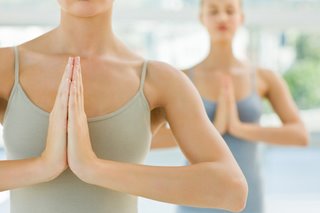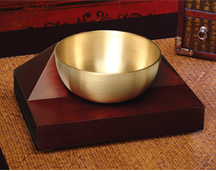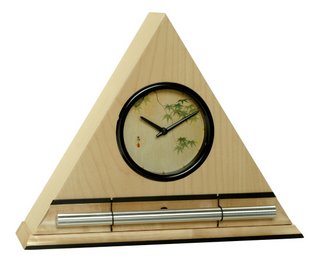
yoga fix
Tension can be a pain in the neck. Master these gentle moves to create lasting ease.
By Barbara Benagh
By the time Tatiana Makoukhina came to my workshop last spring on easing tension in the neck, shoulders, and upper back, she’d been suffering from chronic pain for more than a decade. In the early ’90s, as a single mom newly arrived from Russia, Tatiana worried constantly about whether she could make a new life in America with her daughter. She put in long hours as a hotel cleaner—the only job she could find—and felt she could never relax, never stop working and planning. Her back and neck were constantly rigid with tension, she suffered severe migraines, and then she herniated a disk in her lower back lifting a heavy mattress.
Despite her persistent discomfort, Tatiana worked hard to manage her pain and improve her health. Athletic in her childhood—she had loved gymnastics, volleyball, and dancing—she began running and exercising again. Surgery for her disk injury helped with her lower back pain, and her migraines eased once she began practicing yoga regularly in 2002. Still, nothing seemed to banish the tightness, aches, and occasional stabbing pain in her shoulders and neck.
Tatiana certainly isn’t unique: We all live in a world filled with anxiety. We race through hectic days and fall into bed exhausted; we fret over our bills, our kids, our jobs and the state of the planet, too. It doesn’t help that many of us have lives skewed toward the sedentary, with too many hours spent hunkered down behind a computer or steering wheel. Our stress often winds up stored in clenched necks, shoulders, and backs-which eventually weakens our muscles, strains our joints, and limits our range of motion. The tension hangs heavy on our necks and shoulders, as unwelcome as a winter coat on a summer day.
It doesn’t have to be this way, of course. The shoulder girdle is designed so your arms, neck, and shoulders can move freely and easily. Even if you have a history of injuries or have suffered from chronic tension for years, the approach I’ve developed can help you learn to soften your neck and shoulder muscles and restore ease and freedom.
When I ran into Tatiana a few weeks after the workshop, she was thrilled with her progress. Not only had the workshop taken away her pain but, even better, she’d been able to stay pain-free by including 5 to 10 minutes of my exercises in her daily hour of yoga. Her back, shoulders, and neck were feeling more relaxed than she’d ever imagined possible.
Learn to Let Go
Passive relaxation exercises are the core of my program. Just about anyone can benefit from them, even those who’ve never done a single asana. These poses give you a taste of ease and comfort, a touchstone experience you can refer to again and again as you progress into more active exercises and challenging yoga poses.
Relaxing deeply is a sanctuary, yet few of us allow ourselves to enter it. It feels so good that you’d think it would come easily, but many of us are so accustomed to tension that we have to relearn the natural process of letting go.
The first step is simply lying down on your back on a firm, comfortable surface and letting yourself rest. Almost certainly, you’ll feel your muscles naturally releasing tension because they no longer have to work to hold you upright. You may notice you spontaneously let out a sigh of relief.
To relax more deeply, though, you have to consciously build on these natural responses. The secret to doing this is to focus on the movement of the breath in your body, using it to uncover and melt away tension.
Begin by tuning in to your breath. Pick up its rhythm, letting your muscles relax into and move with its gentle rise and fall. Throughout your practice, let this rhythm hold your attention. Feel how your breath creates an effortless expansion and contraction. Also notice any places in your body that seem tense or immobile or unresponsive to the ebb and flow of your breathing. To help them release, imagine saturating these tight, dull areas with the easy rhythm of your breath; if that doesn’t work, imagine your breath originating deep within your tense places.
Bringing your attention to your contracted spots will probably help them release. But if you’re like most people, you’ll also discover tension that’s stubbornly resistant to letting go. When that happens, remember to be patient and curious.
Chronically clenched muscles can feel tender, sore, rock hard, numb—or some combination of these sensations. Let your awareness drop deeper and deeper into each tight area, getting to know its specific character. With your breath, ask your muscles to slowly shift from tension to release, from density to expansion, from hard to soft.
Once you’ve experimented with this undoing process, apply it in some simple reclining positions like the Neck Blanket Stretch and the Arm-under-Back Stretch. These positions use body weight, position, and basic props to create gentle traction on classic neck and shoulder hot spots.
As you explore these passive exercises, don’t expect your tensions to melt away instantly. To undo your chronic patterns of holding, you have to learn to focus completely on letting go, and that takes time. Your undoing skills will mature with practice. The more often and more deeply you relax, the deeper your breath will penetrate, and the more subtle your awareness will become.
By starting the undoing process, you’ve begun a conversation with the residue your past has left behind in your body. Not only can the process lead you to much greater comfort, but it can also be profoundly contemplative and rich with insight. As you relax, you may discover emotions and memories that seem to have been locked within your tension. Years after my accident, I uncovered a surprising amount of anger at my sister for pushing me to go on that fateful date. The undoing process has led me to unexpected stores of positive feelings, too; when I began to practice again after a nearly fatal asthma attack, I found myself flooded with joy and gratitude.
As you continue to release chronic muscular holding, you’ll sense that contraction creates subtle vibrations of mental unease, and as these dissipate, you’ll discover that easing tension from your neck and shoulders calms your mind, too.

Yoga Timer with Tibetan Singing Bowl
Use our unique “Zen Clock” which functions as a Yoga Timer. It features a long-resonating acoustic chime that brings your meditation or yoga session to a gradual close, preserving the environment of stillness while also acting as an effective time signal. Our Yoga Timer & Clock can be programmed to chime at the end of the meditation or yoga session or periodically throughout the session as a kind of sonic yantra. The beauty and functionality of the Zen Clock/Timer makes it a meditation tool that can actually help you “make time” for meditation in your life. Bring yourself back to balance.

yoga accessories
Now & Zen’s Yoga Timer Shop
1638 Pearl St.
Boulder, CO 80302
(800) 779-6383
Adapted from Yoga Journal.com by Barbara Benagh has taught yoga for 30 years. She lives in Boston and cofounded the Cambridge studio Yoga 301. Her website is www.yogastudio.org.
Posted in yoga, Yoga Timer, Yoga Timers by Now & Zen